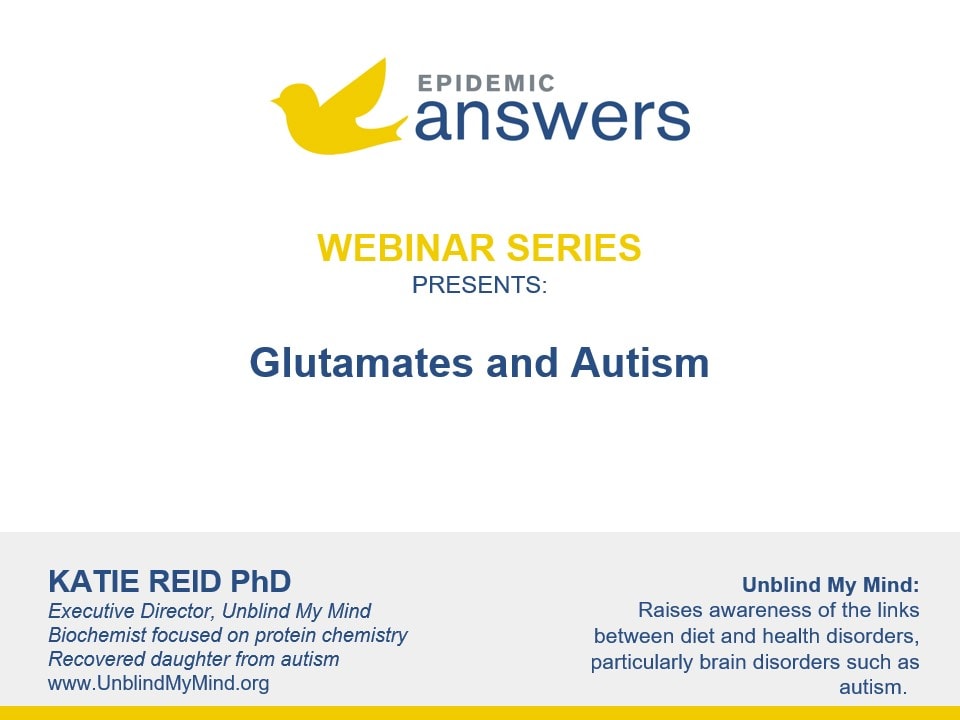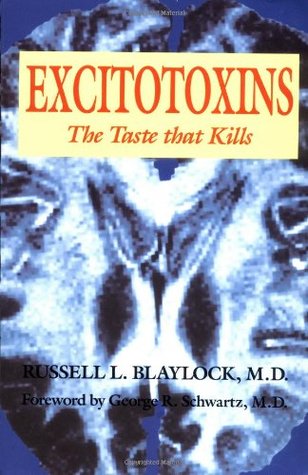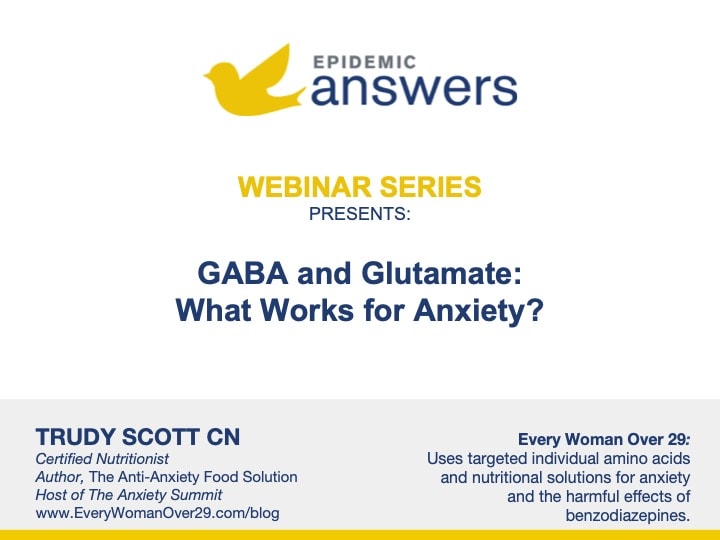One mom in California, biochemist Katherine Reid PhD, used her science-based knowledge to create a low-glutamate diet that stabilizes protein and eliminates all inflammatory foods that were excitatory for her daughter with autism. The diet is called the Reduced Excitatory Inflammatory Diet (REID). With this low glutamate diet, Dr. Reid’s daughter rather quickly extinguished all “autism-like” behaviors and eventually recovered from autism.
What Is Glutamate?
Glutamate is an amino acid that is the most abundant neurotransmitter in the brain. It regulates the receptors of other important neurotransmitters such as:
- Serotonin
- Dopamine
- Norepinephrine
- Acetylcholine
Dopamine and norepinephrine are part of a group of neurotransmitters called catecholamines which are hormones released into the bloodstream by the adrenals in response to physical or emotional stress.
Serotonin is the neurotransmitter that regulates:
- Mood
- Appetite
- Social behavior
- Digestion
- Sleep
- Memory
- Motor
- Cognitive behavior
- Automatic behavior
- Libido
Acetylcholine regulates:
- Attention
- Memory
- Cognition
- Muscle contraction
Glutamate makes the interaction of all these neurotransmitters in the brain function so we can:
- Walk
- Talk
- Learn
- Have emotions
- Be social
- Sing
- Have memory
Glutamate receptors also have a major role in not only long- and short-term memory but also the development of memories from experience.
The Problem with Glutamate
As important as glutamate is for brain functioning, it is also a double-edged sword in the brain. Glutamate is one of the most destructive compounds in the brain, but only when it is found in excess outside of brain cells. This means eating foods high in free glutamate will cause the excess glutamate to remain outside of brain cells. The brain tries to maintain a low level of glutamate outside of the brain cell.
High levels of free glutamates:
- Release opioids in the brain, triggering feelings of spaciness
- Deplete glutathione levels, the master antioxidant in the body that is necessary for detoxification, reducing inflammation and supporting a healthy gut
- Increase the survival of unwanted microbes in the microbiome
- Contribute to an acidic gut condition causing heartburn and reflux
- Can also lead to too much acetylcholine causing:
- A chronic state of stress
- Bladder contractions
- Strabismus (right and left eyes are not balanced which indicates a processing problem of the right and left hemispheres in the brain)
However, the brain has a more difficult time keeping low levels of glutamate outside of the cells when the following are present:
- Toxic heavy metals such as:
- Aluminum
- Mercury
- Lead
- Tin
- Glyphosate and other pesticides
- Strokes
- Seizures
- Brain tumors
- Traumatic Brain Injury/concussion
- Autoimmune diseases
- Infections that have crossed the blood-brain barrier (PANS/PANDAS)
- Brain inflammation stemming from any of the above factors or other factors
- Electromagnetic frequencies (EMFs)
Calcium Channels
Research shows that the development of glutamate-induced brain-cell death depends strongly on calcium channels in the brain. Excess calcium in the body and glutamate together can cause ongoing misfiring of neurons, becoming a vicious cycle resulting in neural inflammation and cell death (excitotoxicity). Glutamate is the gun while calcium is the bullet!
In addition, EMFs such as that from cell phones, wireless phones, WiFi routers, baby monitors, etc., cause these calcium channels to flood via N-methyl-D-aspartate receptors, which are essentially glutamate receptors. In fact, EMFs not only cause this flooding of calcium channels, but they can also cause a blood-brain-barrier breech and thus allow infections to invade the brain, leading to PANS/PANDAS. Infections in the brain cause brain inflammation and can lead to immunoexcitoxicity.
Brain Inflammation and Immunoexcitoxicity
Once there is brain inflammation, special immune cells called microglia cells, which are normally in a semi-resting state, now become very active trying to reduce glutamate levels in the brain by making sure they are not too high. If the brain is damaged or exposed to toxins, these activated microglia cells can become destructive to the brain’s cells and connections.
Because microglia cells are immune cells, they have the mechanism to become inflamed and trigger excitotoxcity at the same time they are acting as an immune cell; this condition is called immunoexcitoxicity. Because of certain medical conditions or toxicity in the brain, the microglia cells can become stuck in a destructive mode which can lead to neurodegenerative conditions and diseases.
In order to keep these microglia cells in a reparative mode to reduce glutamates, it may be necessary to have your child eat a low glutamate diet.
Conditions Associated with High Free Glutamates
High free glutamates are found in conditions such as:
- Autism
- ADD/ADHD
- Sensory Processing Disorder
- Tourette Syndrome
- PANDAS and PANS
- Insomnia
- Bedwetting
- OCD
- Bipolar disorders
- Anxiety disorders
- STIMs (self-stimulatory behaviors) such as:
- Rocking
- Pacing
- Body spinning
- Hand-flapping
- Lining up or spinning toys
- Echolalia (repeating phrases)
- Repetitive body movements
Understanding How GABA Works in the Brain
GABA (Gamma-AminoButyric Acid) is an amino acid that regulates the autonomic nervous system which maintains balance between the parasympathetic and sympathetic (fight or flight) nervous systems. GABA and glutamate balance each other, so if GABA is low, then glutamate is high. GABA, being the opposite of glutamate, has the following functions:
- Calms down the brain
- Slows down racing feelings
- Relaxes the body
- Increases production in the brain of alpha waves, slow brain waves that produce a reflective meditative state
- Is needed for speech and language production, comprehension, conversation and the pause and space between words
- Maintains healthy levels of IgA (antibodies that protect the gut and other mucous linings from harmful foreign toxic matter) which supports a healthy immune system and prevents a “leaky gut” with food sensitivities and intolerances
- Is needed for action of the pituitary which regulates sleep and HPA axis which regulates stress response
Decreased levels of GABA may cause:
- Anti-social behavior
- Attention deficits
- Eye focusing towards the nose
- GERD (acid reflux)
- Sugar and carb cravings
- Adrenal fatigue
- Insomnia
- Chemical sensitivities
- Chronic Fatigue Syndrome
Researchers have found that children with autism have less GABA in the motor cortex and the auditory cortex which accounts for the sensory abnormalities found in children with autism. GABA receptors are found in the gastrointestinal tract and are important for bowel contraction to avoid constipation, abdominal pain and impaired transit. GABA is found in almost every area of the brain and in very high levels in the hypothalamus. The hypothalamus requires GABA production to:
- Regulate sleep
- Regulate appetite
- Regulate body temperature
- Regulate thirst
- Regulate sexual arousal and desire
GABA and Glutamate Must Be Balanced
We cannot talk about glutamates without understanding about GABA and how important a balance between both neurotransmitters is necessary for appropriate brain functioning. Glutamate is an excitatory neurotransmitter, while GABA is an inhibitory neurotransmitter. Both the nervous system and the neurological system are severely impacted if there is excessive glutamate in relation to GABA. A host of conditions are associated with a GABA/glutamate imbalance:
- Neurological symptoms
- Alzheimer’s
- Other forms of dementia
- Parkinson’s
- ALS
Excessive glutamates, which come primarily from one’s diet, can overstimulate the nervous system and produce adverse neurological symptoms which affect:
- Mood
- Energy levels
- Mental stability
- Speech
- Behaviors
- Motor skills
- Sleep
- Resilience
- Hormonal functioning
When the immune system is compromised and not functioning properly, then a GABA/glutamate imbalance becomes more pronounced and problematic.
In the case of children with autism, the immune system is overactive and if the child has a diet of excessive glutamates, then an inflammatory condition in the brain called excitotoxicity is triggered. Excitotoxicity is the destruction of brain cells by glutamates when excessive glutamates are found in the brain because they cause the cell to become extremely excited which can ultimately lead to cell death (apoptosis).
Excitotoxicity can produce many neurological symptoms in children with autism; in fact, autism is considered a “hyper-glutamate condition”. Therefore, reducing glutamates and increasing GABA is one way to restore the GABA/glutamate balance needed for appropriate brain functioning. A low free-glutamate diet is one way to reduce excessive glutamates in the brain.
What Causes a Glutamate and GABA Imbalance?
There are a multitude of factors going on in the brain that contribute to the excessive glutamate and reduced GABA, especially for children with neurodevelopmental disorders such as autism, ADHD and Sensory Processing Disorder. Excessive glutamate found in the brain convert to GABA automatically through an enzyme called Glutamic Acid Decarboxylase (GAD).
This conversion through GAD can be impaired due to the following interfering factors:
- Too much free glutamate coming from dietary sources (believed to be the primary issue)
- The rubella virus can reduce GAD by as much as 50%, which may be why many children lose their speech and exhibit symptoms of autism after exposure to this virus.
- Chronic infections that have crossed the blood-brain barrier, such as seen in PANDAS, PANS and Autoimmune Encephalitis
- Impaired methylation, which causes folate not to get utilized effectively
- Lead, mercury, aluminum and other heavy metals
- Antibodies to the pancreas
- Other GAD65 autoantibodies
- The pulling by glutamate receptors in the brain of other excitatory substances into the cells such as:
- Aspartate
- Aspartame
- Glutamic acid
- Aspartic acid
- Glutamine
- Monosodium glutamate (MSG)
- Cysteine (but not NAC)
- Homocysteine
- The presence of electromagnetic fields (EMFs) such as that from cell phones, wireless phones, WiFi routers, baby monitors, etc. EMFs have been found to modulate glutamate and GABA, even at very low intensities.
Basic Guidelines of a Low Glutamate Diet
Although at first it may seem as if it’s a lot of work to implement a low glutamate diet, the payoff is that you as a parent will know very quickly, within a matter of weeks, if not days or hours, if your child’s symptoms are improving by avoiding foods that are high in glutamate.
Be sure to keep a daily food diary and be sure to look for improvements or decline in your child’s physical, emotional, behavioral and academic symptoms. By keeping a detailed diary and looking back on it over time, you’ll be able to gain some insight as to what particular foods or even situations, such as being at a school with heavy WiFi usage or a mold issue, that exacerbate your child’s symptoms. With that in mind, see below to know which foods to avoid.
Avoid High Free-Glutamate Foods
Foods that typically have the fifth taste known as umami, which is a savory taste, are typically high in free glutamates. Many of these are processed foods/ingredients such as:
- Monosodium glutamate
- Gluten
- Casein (found in dairy products)
- Soy sauce / tamari (gluten-free soy sauce)
- Coconut aminos
- Bragg’s aminos
- Anything containing “glutamate”
- Anything containing “hydrolyzed”
- Anything “autolyzed”
- Any protein “isolate”
- Whey
- Protein powders
- Gelatin
- Bouillon
- Broth
- Stock
- Any flavors or flavoring, both “natural” and artificial
- Citric acid and/or citrate
- Carrageenan
- Corn starch
- Maltodextrin
- Vinegars
- Yeast extract
- Nutritional yeast
- Brewer’s yeast
- Ramen noodles
- Skim, 1%, 2%, non-fat, or dry milk
- Processed meats/cold cuts
- Xanthum and other gums
- Aspartame (NutraSweet) isn’t glutamate but acts in the same manner
- Many spice mixes (call the manufacturer if you’re not sure)
- Others
However, even some non-processed foods can contain high levels of glutamate:
- Seaweed
- Tomatoes
- Mushrooms
- Broccoli
- Peas
- Corn
- Grapes
- Parmesan cheese
- Potatoes
- Walnuts
For more information about foods that contain high amounts of free glutamates, please see The Truth In Labeling Campaign’s list of ingredient names used to hide manufactured free glutamate. For further information on the diet and recommendations of processed foods that do not contain high amounts of free glutamates, please see Dr. Reid’s pantry list of recommended foods.
Other Recommendations
More work must be done beyond implementing a low glutamate diet to avoid high levels of this potentially troublesome neurotransmitter. The best way to avoid high free glutamates is to cook whole foods yourself from scratch at home, but even then, there are pitfalls to avoid. Here are other recommendations to avoid high free glutamate foods:
- Manage blood sugar, as hypoglycemia (low blood sugar) can trigger the release of glutamate.
- Eliminate all gluten and casein products.
- Be mindful of “gluten free” processed products such as bread, crackers and many snack items because they may contain free glutamates.
- Check the label of any store-bought food.
- Choose organic, non-GMO (Genetically Modified Organisms) produce because GMO foods are sometimes sprayed with a free glutamate called AuxiGrow during the growing cycle
- It is better to buy whole fresh foods rather than buy canned or packaged foods that have free glutamates in them. If you are not sure, contact the manufacturer directly.
- Eliminate all bottled juices and drinks with a shelf life unless they are freshly squeezed because a ingredients containing glutamates such as citric acid are typically used to preserve them.
- Avoid slow cooking meats because that frees up more glutamates from protein.
- Avoid lunch meats because they contain high levels of free glutamates.
- Avoid all power drinks, power bars, protein bars and protein shakes except for certain brands recommended by Dr. Reid.
- Avoid white rice because free glutamates are involved in the processing of it. Black and red varieties do not produce glutamates during the processing.
- Be wary of spice mixes as many of them contain hidden glutamate.
The daily portions of whole foods are broken down as follows to ensure a healthy nutrient balance in a low glutamate diet:
- 75% raw and cooked high-fiber vegetables
- 10% whole proteins
- 10% fat/oils
- 5% fruits
- Unlimited herbs
How to Reduce Glutamates, Excitotoxicity and Promote GABA
Other factors, including supplements, can increase or decrease glutamate.
Any supplement or drug listed below should be discussed with your child’s practitioner.
- Increase GAD by supplementing with L-taurine, gotu kola and valerian root to help facilitate the conversion into GABA in the brain.
- Increase magnesium levels to offset calcium levels and stop glutamate misfiring.
- Supplement with magnesium L-threonate, a form of magnesium that can cross the blood-brain barrier.
- Avoid supplementing with calcium; use chamomile, lavender, nettles, vegetables and lightly cooked bone broth for calcium intake.
- Limit the amount of vitamin D3 because it increases calcium, especially if not taken with vitamin K2.
- Supplement with lithium orotate to reduce the amount of glutamate in the brain and promote GABA.
- Supplement with N-acetylcysteine (NAC), green tea and omega-3 fatty acids such as cod liver oil to block glutamates.
- Supplement with bacopa to reduce excitotoxicity, brain inflammation and improve blood flow to the brain. This supplement is especially helpful for diabetics.
- Supplement with both zinc picolinate and vitamin B6 (P5P) to help reduce excitotoxicity.
- Supplement with phenylethylamine (PEA) and honokiol to reduce excitotoxicity.
- Supplement with selenium, B vitamins, polyphenols, bioflavonoids, carotenoids, vitamin E and vitamin C because they all have unique properties which are beneficial in protecting the brain.
- Increase serotonin by supplementing with 5-HTP or SAMe and by healing the gastrointestinal tract.
- Increase gut microbes with a multi strain probiotic such as Kirkman Labs Microbiome Probiotic.
- Be cautious in supplementing with GABA, as it may convert back to glutamine and then glutamate.
- Supplement with PharmaGABA because it gets GABA into the brain without converting into glutamine or glutamate.
- Reduce Candida overgrowth because Candida converts to glutamate.
- Eliminate excitotoxins and glutamates in the diet (see above recommendations).
- Eliminate gluten and casein because they contain glutamates.
- Eliminate foods that increase histamines such as fermented foods (soy sauce, sauerkraut and vinegar, for example).
- Consume only bone broth that has been cooked for only a few hours; longer cooking leads to higher levels of free glutmate.
- Limit usage of glutathione because it contains glutamate.
- Speak with your child’s doctor if they are on medications that target GABA receptors because they can deplete the neurotransmitter GABA and affect the ability to maintain and balance GABA. Examples of these medications are:
- Ativan
- Xanax
- Klonapin
- Valium
- Gabapentin
- See a MAPS physician to have your child’s GAD levels checked.
Still Looking for Answers?
Visit the Epidemic Answers Practitioner Directory to find a practitioner near you.
Join us inside our online membership community for parents, Healing Together, where you’ll find even more healing resources, expert guidance, and a community to support you every step of your child’s healing journey.
Sources & References
Bauer, J., et al. Hyperactivity and impulsivity in adult attention-deficit/hyperactivity disorder is related to glutamatergic dysfunction in the anterior cingulate cortex. World J Biol Psychiatry. 2018 Oct;19(7):538-546.
Blaylock, R.L., et al. Natural plant products and extracts that reduce immunoexcitotoxicity-associated neurodegeneration and promote repair within the central nervous system. Surg Neurol Int. 2012;3:19
Blaylock, R.L. A possible central mechanism in autism spectrum disorders, part 1. Altern Ther Health Med. 2008 Nov-Dec;14(6):46-53.
Blaylock, R.L. A possible central mechanism in autism spectrum disorders, part 2: immunoexcitotoxicity. Altern Ther Health Med. 2009 Jan-Feb;15(1):60-7.
Blaylock, R.L. A possible central mechanism in autism spectrum disorders, part 3: the role of excitotoxin food additives and the synergistic effects of other environmental toxins. Altern Ther Health Med. 2009 Mar-Apr;15(2):56-60.
Blaylock, R.L., et al. Immune-glutamatergic dysfunction as a central mechanism of the autism spectrum disorders. Curr Med Chem. 2009;16(2):157-70.
Bravo, J.A., et al. Ingestion of Lactobacillus strain regulates emotional behavior and central GABA receptor expression in a mouse via the vagus nerve. Proc Natl Acad Sci U S A. 2011 Sep 20;108(38):16050-5.
Breitenkamp, A.F., et al. Voltage-gated Calcium Channels and Autism Spectrum Disorders. Curr Mol Pharmacol. 2015;8(2):123-32.
Brown, M.S., et al. Increased glutamate concentration in the auditory cortex of persons with autism and first-degreer elatives: A(1)H-MR study. Autism Res. 2013;6(1):1–10.
Cartmell, J., et al. Regulation of neurotransmitter release by metabotropic glutamate receptors. J Neurochem. 2000 Sep;75(3):889-907.
Chapman, G. Glutamate and epilepsy. J Nutr. 2000 Apr;130(4S Suppl):1043S-5S.
Choudhury, P.R., et al. Glutamate mediated signaling in the pathophysiology of autism spectrum disorders. Pharmacol Biochem Behav 100(2012)841–849
Cocito, L., et al. GABA and phosphatidylserine in human photosensitivity: a pilot study. Epilepsy Res. 1994 Jan;17(1):49-53.
Coghlan, S., et al. GABA System Dysfunction in Autism and Related Disorders: From Synapse to Symptoms. Neurosci Biobehav Rev. 2012;36(9):2044–2055.
Davalli, D.M., et al. The potential role of glutamate in the current diabetes epidemic. Acta Diabetol. 2012 Jun;49(3):167-83.
DeHavenon, A., et al. The Secret “Spice”: An Undetectable Toxic Cause of Seizure. Neurohospitalist. 2011 Oct; 1(4): 182–186.
Ding, H., et al. Molecular Pathogenesis of Anti-NMDAR Encephalitis. Biomed Res Int. 2015;2015:643409.
D’Souza, C.E., et al. GAD65 antibody-associated autoimmune epilepsy with unique independent bitemporal-onset ictal asystole. Epileptic Disord. 2018 Jun 1;20(3):204-208.
Eimerl, S., et al. Acute glutamate toxicity and its potentiation by serum albumin are determined by the Ca2+ concentration. Neurosci Lett. 130 (1991) 125–127.
El-Ansary, A. GABA and Glutamate Imbalance in Autism and Their Reversal as Novel Hypothesis for Effective Treatment Strategy. Autism and Developmental Disorders. 18, no. 3 (2020): 46-63.
Ende, G., et al. Impulsivity and Aggression in Female BPD and ADHD Patients: Association with ACC Glutamate and GABA Concentrations. Neuropsychopharmacology. 2016 Jan;41(2):410-8.
Essa, M.M., et al. Excitotoxicity in the pathogenesis of autism. Neurotox Res. 2013 May;23(4):393-400.
Feng, Z.M., et al. Monosodium L-Glutamate and Dietary Fat Differently Modify the Composition of the Intestinal Microbiota in Growing Pigs. Obes Facts. 2015;8(2):87-100.
Fernell, E. Further studies of GABA and Glutamate imbalances in autism are important challenges for future research. Acta Paediatr. 2019 Feb;108(2):200-201.
Ford, T.C., et al. Psychosocial deficits across autism and schizotypal spectra are interactively modulated by excitatory and inhibitory neurotransmission. Autism. 2019 Jul 24:1362361319866030.
Gilliam, L.K., et al. Multiplicity of the antibody response to GAD65 in Type I diabetes. Clin Exp Immunol. 2004;138(2):337–341.
Hacohen, Y., et al. N‐methyl‐d‐aspartate (NMDA) receptor antibodies encephalitis mimicking an autistic regression. Dev Med Child Neurol. 2016 Oct;58(10):1092-4.
Haroon, E., et al. Inflammation, Glutamate, and Glia: A Trio of Trouble in Mood Disorders. Neuropsychopharmacology. 2017 Jan;42(1):193-215.
Hassel, B., et al. Brain infection with Staphylococcus aureus leads to high extracellular levels of glutamate, aspartate, γ-aminobutyric acid, and zinc. J Neurosci Res. 2014 Dec;92(12):1792-800.
Herbert, M.R, et al. Autism and EMF? Plausibility of a pathophysiological link–Part I. Pathophysiology 20.3 (2013): 191-209.
Herbert, M.R., et al. Autism and EMF? Plausibility of a pathophysiological link Part II. Pathophysiology 20.3 (2013): 211-234.
Huang, Y., et al. Pyridoxine Supplementation Improves the Activity of Recombinant Glutamate Decarboxylase and the Enzymatic Production of Gama-Aminobutyric Acid. PLoS One. 2016 Jul 20;11(7):e0157466.
Hughes, R., et al. Protein degradation in the large intestine: relevance to colorectal cancer. Curr Issues Intest Microbiol. 2000 Sep;1(2):51-8.
Humphries, P., et al. Direct and indirect cellular effects of aspartame on the brain. Eur J Clin Nutr. 2008 Apr;62(4):451-62.
Kash, S.F., et al. Epilepsy in mice deficient in the 65-kDa isoform of glutamic acid decarboxylase. Proc Natl Acad Sci U S A. 1997;94(25):14060–14065.
Khalifa, D., et al. Serum glutamate was elevated in children aged 3-10 years with autism spectrum disorders when they were compared with controls. Acta Paediatr. 2019 Feb;108(2):295-299.
Luo, P., et al. The role of glutamate receptors in traumatic brain injury: implications for postsynaptic density in pathophysiology. Brain Res Bull. 2011 Jul 15;85(6):313-20.
, J.Z., et al. Prenatal exposure to fipronil disturbs maternal aggressive behavior in rats. Neurotoxicol Teratol. Nov-Dec 2015;52(Pt A):11-6.
Manev, H., et al. Delayed increase of Ca2+ influx elicited by glutamate: role in neuronal death. Mol Pharmacol. 1989 Jul;36(1):106-12.
McNally, L., et al. Inflammation, glutamate, and glia in depression: a literature review. CNS Spectr. 2008 Jun;13(6):501-10.
Naaijen, J., et al. Fronto-Striatal Glutamate in Autism Spectrum Disorder and Obsessive Compulsive Disorder. Neuropsychopharmacology. 2017 Nov;42(12):2456-2465.
Napolini, V., et al. The mitochondrial aspartate/glutamate carrier AGC1 and calcium homeostasis: Physiological links and abnormalities in autism. Mol Neurobiol. 44 (2011) 83–92.
Onaolapo, A.Y., et al. Glutamate and depression: Reflecting a deepening knowledge of the gut and brain effects of a ubiquitous molecule. World J Psychiatry. 2021 Jul 19;11(7):297-315.
Ou, D., et al. Cross-reactive rubella virus and glutamic acid decarboxylase (65 and 67) protein determinants recognised by T cells of patients with Type I diabetes mellitus. Diabetologia. 2000 Jun;43(6):750-62.
Pall, M.L., The Autism Epidemic Is Caused by EMFs, Acting via Calcium Channels and Chemicals Acting via NMDA-Rs: Downstream Effects Cause Autism (conference presentation). 2015.
Pall, M.L., Electromagnetic fields act via activation of voltage‐gated calcium channels to produce beneficial or adverse effects. Journal of Cellular and Molecular Medicine 17.8 (2013): 958-965.
Palmieri, L., et al. Altered calcium homeostasis in autism-spectrum disorders: evidence from biochemical and genetic studies of the mitochondrial aspartate/glutamate carrier AGC. Mol Psychiatry. 2010 Jan;15(1):38-52.
Pelsser, L.M., et al. Effects of a restricted elimination diet on the behaviour of children with attention-deficit hyperactivity disorder (INCA study): a randomised controlled trial. Lancet. 2011 Feb 5;377(9764):494-503.
Pitt, D., et al. Glutamate excitotoxicity in a model of multiple sclerosis. Nat Med. 2000 Jan;6(1):67-70.
Qi, J., et al. Enhanced susceptibility to stress and seizures in GAD65 deficient mice. PLoS One. 2018 Jan 29;13(1):e0191794.
Rojas, D.C. The role of glutamate and its receptors in autism and the use of glutamate receptor antagonists in treatment. J Neural Transm (Vienna). 2014;121(8):891–905.
Rout, U.K., et al. Presence of GAD65 autoantibodies in the serum of children with autism or ADHD. Eur Child Adolesc Psychiatry. 2012 Mar;21(3):141-7.
Rowley, N.M., et al. Glutamate and GABA synthesis, release, transport and metabolism as targets for seizure control. Neurochem Int. 2012 Sep;61(4):546-58.
Sai, Y., et al. Clinical diagnosis and treatment of pediatric anti-N-methyl-D-aspartate receptor encephalitis: A single center retrospective study. Exp Ther Med. 2018 Aug;16(2):1442-1448.
Samuels, A. The toxicity/safety of processed free glutamic acid (MSG): a study in suppression of information. Account Res. 1999;6(4):259-310.
Schauwecker, P.A. The effects of glycemic control on seizures and seizure-induced excitotoxic cell death. BMC Neurosci. 2012 Aug 6;13:94.
Silvestrin, R.B., et al. Animal model of autism induced by prenatal exposure to valproate: altered glutamate metabolism in the hippocampus. BrainRes. 1495 (2013) 52–60.
Takano, T., et al. Glutamate release promotes growth of malignant gliomas. Nat Med. 2001 Sep;7(9):1010-5.
Tang, J., et al. Exposure to 900 MHz electromagnetic fields activates the mkp-1/ERK pathway and causes blood-brain barrier damage and cognitive impairment in rats. Brain Res. 2015 Mar 19;1601:92-101.
Terpstra, M., et al. Changes in human brain glutamate concentration during hypoglycemia: insights into cerebral adaptations in hypoglycemia-associated autonomic failure in type 1 diabetes. J Cereb Blood Flow Metab. 2014;34(5):876–882.
Tzang, R.F., et al. Autism Associated With Anti-NMDAR Encephalitis: Glutamate-Related Therapy. Front Psychiatry. 2019 Jun 21;10:440.
Walls, A.B., et al. GAD65 is essential for synthesis of GABA destined for tonic inhibition regulating epileptiform activity. J Neurochem. 2010 Dec;115(6):1398-408.
Wang, Hsiuying. Anti-NMDA Receptor Encephalitis. Int J Mol Sci. 2017 Jan 18;18(1). pii: E193.
Watkins, J.C., et al. The glutamate story. Br J Pharmacol. 2006 Jan; 147(Suppl 1): S100–S108.
Yang, Y., et al. Role of metabotropic glutamate receptor 7 in autism spectrum disorders: A pilot study. Life Sci. 92 (2013) 149–153.
Zhang, Z., et al. Blood Glutamate Levels in Autism Spectrum Disorder: A Systematic Review and Meta-Analysis. PLoS One. 2016 Jul 8;11(7):e0158688.
Resources
Books
Adams, Mike.The Truth About Aspartame, MSG and Excitoxins. Truth Publishing, Inc., 2010.
Blaylock MD, Russell. Excitoxins: The Taste That Kills. Health Press, 1996.
Lambert, Beth, et al. Brain Under Attack: A Resource for Parents and Caregivers of Children with PANS, PANDAS and Autoimmune Encephalitis. Answers Publications, 2018.
Ross, Julia. The Mood Cure: The 4-Step Program to Take Charge of Your Emotions–Today. Penguin Life, 2003.
Scott, Trudy. The Antianxiety Food Solution: How the Foods You Eat Can Help You Calm Your Anxious Mind, Improve Your Mood and End Cravings. New Harbinger Publications, 2011.
Presentations
Pall, Martin. EMFs and Chemicals as the Main Drivers of the Autism Epidemic: Mechanisms of Action. AutismOne Conference, 2017.
Websites
Amy Yasko’s list of foods with high free glutamates
Amy Yasko’s list of neuroprovokers
How to Increase GABA and Balance Glutamate: Article by Amy Yasko PhD, ND biochemist
Katie Reid’s pantry list of recommended foods.
MSG: Deadly Menace in Your Food: Article by Russell Blaylock MD, neurosurgeon
Natural plant products and extracts that reduce immunoexcitotoxicity-associated neurodegeneration and promote repair within the central nervous system: Peer-reviewed article by Russell Blaylock MD, neurosurgeon
Unblind My Mind: Dr. Reid’s website gives extensive explanation about the science, a TED talk by Dr. Reid and video tutorials to help parent’s discern appropriate foods in a local supermarket
Videos
Excitotoxins, Neurotoxins & Human Neurological Disease Lecture by Russell Blaylock MD
Glutamate, Excitoxicity and Autism
Unblind My Mind: What Are We Eating? Dr. Katherine Reid at TEDxYouth@GrassValley




